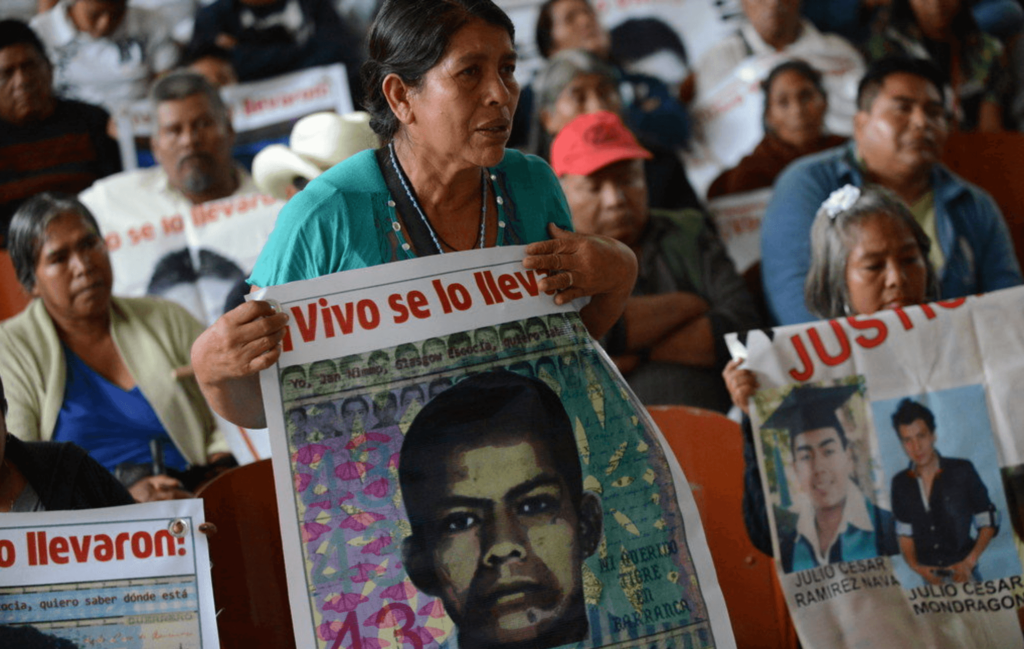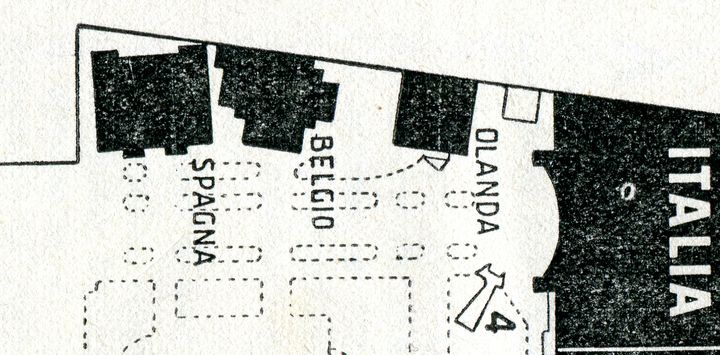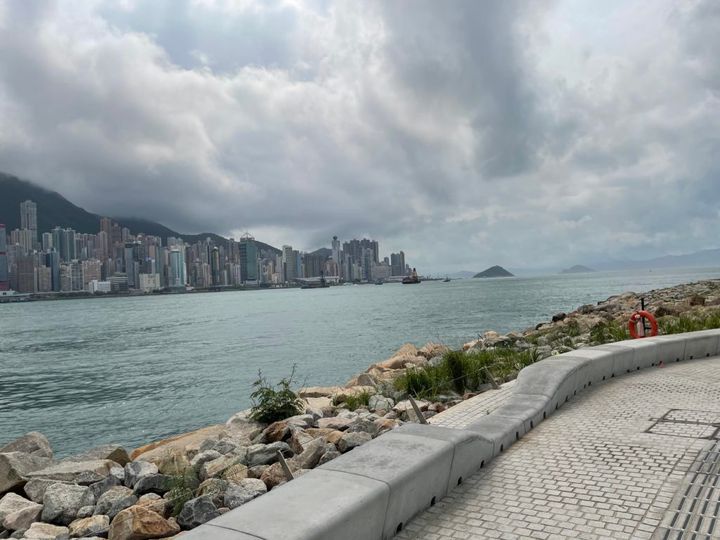The case of the 43 students was one of the darkest episodes of human rights violations in the recent history of Mexico. Both inside and outside the country, the news about the brutal attacks on 17-18 year-old students of the Ayotzinapa school, in the hands of the local police and the organised crime, led to multiple displays of outrage (GIEI, 2015, 2016). From national protests, and international press coverage, to multilateral cooperation of governments and NGOs in the pursuit of locating the students and finding out the truth about what happened, the Ayotzinapa case posed an inflection point in Mexico’s public life that has been analysed from many angles (Aguayo, 2015; Beristain, 2017; Escalante and Canseco, 2019). This article, however, focuses particularly on the implications for power distribution and its relation with mechanisms of accountability in Mexico’s public sphere, like journalism, NGOs, and civil organisations in general. In other words, it attempts to respond to the question, what did the case of the 43 students mean for the understanding of the disposition of power in contemporary Mexico and what are its implications for civil mechanisms of power accountability elsewhere?
Who was responsible for the detention, attacks, murders, and ultimate disappearance of the students is a matter of contention up to this day. Why this happened is even a more complicated issue since no one could give a definitive reason or motive behind all the series of attacks. Several hypotheses have been on the table, from the confusion on the part of criminal organisations who thought the students were their enemies (PGR, 2014; Illades, 2014), to the supposition that one of the buses was loaded with a huge amount of drugs or drug-money (Reveles, 2015; Grecko, 2015; Hernández, 2019). There was a big feeling of confusion due to different, conflicting versions, and purposefully made up information on the case (Reforma, 2014).
This was in fact the moment when the focus and approach of accountability mechanisms in Mexico’s public sphere were dislocated. Those responsible for the violence and for the cover-up were not identifiable, the motives behind the crimes were not confirmed, and the whereabouts of 43 students remained unknown. The press, NGOs, victims, academia, and others found themselves before a new set of questions for the analysis of power—what would they believe? and perhaps more importantly, who were they going to hold accountable?
This text argues that the Ayotzinapa case was a moment of reckoning of a rough[1] disposition of power in Mexico, with multiple overlapping faces. This disposition of power was not new, it was rather the realisation of daily politics in people’s lives dealing with the state, criminal organisations, and the public sphere in 21st-Century Mexico. Nonetheless, this reckoning can add complexity to the understanding of power in contemporary Mexico and can open up new approaches to processes of accountability and public scrutiny.
I am taking Ayotzinapa as a paradigm, with all its potential shortcomings and dangers of generalisation, because it is a case of power convergence in contemporary Mexico (i.e. the different levels of the state, legal and illegal actors exerting violence, processes of justice, official and citizen investigations). Furthermore, it lays bare the limitations of traditional understandings of accountability and how these can be challenged by civil initiatives to hold power accountable in the digital era (Dubberley et al, 2020; Higgins, 2021). The Ayotzinapa case is a watershed event, not only for the realisation of the brutality of the legal and illegal structures that sustain power in contemporary Mexico, but also because the amount of information available on the case is second to none.
Next, I will propose three aspects of the disposition of power that the Ayotzinapa case laid bare for the Mexican public sphere to inquire into (i.e. that there is a more horizontal and multifaceted arrangement of power, that the boundaries of the monopoly of the state to investigate are not fixed, and that traditional understandings of public accountability were faced with serious limitations).
-A more horizontal, multifaceted arrangement of power
The Ayotzinapa case showed that power in Mexico is less vertical and more scattered across many players than conventionally thought. This is very often in detriment to justice, putting the federal arrangement of the republic and the limits of legality into question. That night, there were at least 12 different active police or military organisations: five municipal forces, three at the state level, the federal police, the ministerial federal police, the army, and the navy (Forensic Architecture, 2017). The participation of some of these organisations was, in the best case scenario, questionable for inaction, and in the worst, that of direct involvement in the aggression and the enforced disappearance of the students. Not to mention the names of the various criminal organisations related to the case, from Guerreros Unidos, with presence mainly in the Guerrero state and with links to the city mayor, to their supposed enemies Los Rojos, mainly located in neighbouring states like Morelos and the State of Mexico (Reveles, 2015), as well as other minor organisations connected to gangs, criminal organisations and local police members (Beristain, 2017). As it is evident from this list of players in the case, their interactions, roles, responsibilities, capacities, coordination, etcetera, become so intricate and with such level of complexity that it is very hard to establish a clear separation between them—their power and interests are often confounded and they even overlap. An example of this is the city mayor, José Luis Abarca, and his wife, María de los Ángeles Pineda, who were not only local political figures who belonged to a well-established political party; they also played the character of the capitalist entrepreneur in town, since they owned the most important shopping centre in the city, and they were related to the drug trafficking industry (UIE, 2014). But there are several examples of this overlapping: many municipal cops confessed that they had been working alongside criminal organisations in the locality; criminal organisations’ leaders had a background in police forces including the army; and even the students had family links with drug organisations and the military[2], and so on.
All these intricacies of the Ayotzinapa case indicate that the analysis of power in Mexico needs to go beyond the simplistic assumption that there are two defined areas from where to exert violence—the traditional view of a state and a “parallel state” (Chabat, 2005; Aguayo, 2015). The Ayotzinapa case shows that, as in many other instances in the Mexican territory and elsewhere, power requires both legal and illegal ways to operate, and very often making a separation between them does not help to understand power equilibriums and political processes, since the stakeholders at play use diverse platforms and forums to gain, maintain, expand, and even legitimise their power.
-The boundaries of the monopoly of the state to investigate
The Ayotzinapa case showed how the boundaries of the monopoly of the state to investigate crimes are not fixed. This means that ideas of authoritative knowledge, vertical power, and the monopoly of the state to investigate have been resignified and taken up by other actors, most notably citizens. Apart from the traditional journalistic investigations that of course are not part of the state, the Ayotzinapa case triggered diverse efforts to investigate crimes outside the state institutions’ remit. For instance, citizens joined collective searches in order to find the students in the following days after the attacks, walking in Iguala’s surroundings in search teams, looking for traces of life or of human remains (Pie de Página, 2017). Once the case stirred up international outrage, expressions of solidarity were displayed in different capacities. For instance, the interest and demonstrations in many parts of the world, the help offered to investigate the case by NGOs (e.g. the Equipo Argentino de Antropología Forense, EAAF, and European organisations), and even technical and political projects were conducted to inquire into the case, like the Plataforma Ayotzinapa, by a university-based research agency called Forensic Architecture (2017), in Goldsmiths College, which created an investigation platform as a visual representation of the events and as a technological tool to elicit citizen investigations. Naturally, there were still institutional channels for international solidarity, like the GIEI (2015, 2016) that was commissioned by the Interamerican Commission on Human Rights, based on international cooperation accords; interestingly, the GIEI investigators also teamed up with many of the initiatives outside the state realm, including victims, NGOs, and even journalists, to come up with their own hypothesis and conclusions on their assessment of the official investigation, which very often contradicted the official narrative.
Although the surge of independent, citizen investigations is not new in Mexico (e.g. the Marisela Escobedo case, Miranda de Walace case), different organisations and scholarship have recognised a point of inflection for this type of search led by civil groups—usually composed of violence victims’ relatives—after the events in Iguala (Cruz Santiago and Schwartz, 2016; 2018). With the rise of homicides[3] and disappeared people that took off since the declaration of a frontal war on drugs in 2007, the families looking for the whereabouts of their loved ones became a more common phenomenon. By 2014, with the state prosecutors being overwhelmed by a gigantic wave of cases to investigate, and mingled with the public’s perception of incompetency, corruption or sheer complicity with criminal organisations (Parametría, 2014), those who had a disappeared relative could not wait anymore, since their cases were being stockpiled or simply ignored by the authorities (Turati, 2019). According to Turati (2019) and Pie de Página (2017), many passed from being waiting to be seekers, “buscadores”, only when the Ayotzinapa search campaigns started. It was an awakening moment, a realisation that self-organisation to look for the whereabouts of their beloved ones was possible, that they could take action in their hands because if they did not do it, the state was not going to move a finger.
These civil organisations trespassed the security line imposed by state police institutions, to use Weizman’s words (2017), to do forensic research in the field, mapping areas, sketching possible mass graves, digging, sifting, and even smelling the soil in the search for human remains. In fact, they teamed up with other families to create collective organisations, or “colectivos” (e.g. Colectivo Solecito, Las Rastreadoras de El Fuerte) across the country, forming national alliances where they share experiences and technical knowledge to this day, and their political leverage before the authorities and the public becomes stronger (Huffschmid and Hennies, 2019). In this sense, these “buscadores” are the crudest and most radical civil response to the institutional incapacity to bring justice in the middle of the war on drugs, and they were emboldened by the wave of national sympathy towards the disappeared in Mexico that was stirred by the Ayotzinapa case.
-The limitations of traditional understandings of public accountability
Thirdly, the Ayotzinapa case shows the limitations of traditional understandings of “holding power accountable”, a fundamental old adagio in democratic theory. Here I make the case for a broader understanding of civil mechanisms of accountability, and for that purpose I bring the very well-known definition of Schmitter and Mark (1991, p.76) who made a connection between democratic theory and accountability, which says, “modern political democracy is a system of governance in which rulers are held accountable for their actions in the public realm by citizens”. This quote captures the dominant trend in academic literature on the subject, focusing mainly on holding “the rulers” accountable through mechanisms of representation or of evaluating the professional performance of civil servants and their policies (Przeworski et al, 2001; Mulgan, 2000). This approach is helpful to champion the legitimacy of civil mechanisms of accountability, but it easily overlooks other forces exerting power and doing politics too (e.g. private interests, criminal organisations, local economies, and so on), and thus it produces a very limited understanding of the possibilities of holding power accountable, as the Ayotzinapa case can show us. Now, let me deal with some of the most serious limitations of that traditional view—the seemingly elusive object to be held accountable, the folly of gravitating around the truth produced by hegemonic powers, and the fallacy of a purist evidence-based approach.
First, given the more horizontal, multifaceted power arrangement that I have analysed above, the object of accountability is increasingly diffused. Analyses on the complexities of a federal state arrangement, with municipal, state, and federal authorities, plus the separation of power between executive, legislative, and judicial, at every level are not new and its shortcomings have been explored many times before (Casar, 2014; Gómez, 2015). Nonetheless, the Ayotzinapa case shows how the many nooks, gaps, delegation of functions, jurisdictions, and dispersion of power facilitates the dispersion of responsibility. Maintaining the mainstream view that criminal organisations “infiltrated” the public administration is not accurate, and impedes a better analysis of the forces at play for them to really challenge and question the power structures that they generate. In this sense, the multifaceted arrangement of power that the Ayotzinapa case revealed is helpful to see the shortcomings of the common understanding of holding power accountable by civil initiatives.
Second, the case of the 43 students made evident the folly of gravitating around the hegemonic narrative. What the Ayotzinapa case can also teach us about those official documents is that they are fallible and can be subjected to being challenged because of their degree of veracity (González Rodríguez, 2015; Zavala, 2018). Perhaps the crudest example of the danger of gravitating around hegemonic narratives in the Ayotzinapa case was made clear by the project Plataforma Ayotzinapa. In the map created for the narrative analysis of the case, Forensic Architecture (2017) was able to show the overlapping of the official investigation narrative and the version of the presumed guilty defendants, which was obtained under torture. In spite of this, those documents were often used as the highest and most reliable source of truth, and in some cases reproduced verbatim, in books and other means of representation (Illades, 2015; De Mauleón, 2021), precluding every chance of truly holding this version and those who manufactured it accountable.
Third, the Ayotzinapa case laid bare the fallacy of a purist evidence-based approach to study events. Some of the very well-intended journalists, lawyers and advocates push for the practice of “fact-finding” (Koettl, 2016; Dubberley et al, 2020), in order to raise awareness and hold power to account in cases of human rights violations or other types of wrongdoing. Based on assumptions of certain schools of scientific knowledge and a tradition of objective reporting in journalism, the “fact-finders” strive to get documentary evidence of events—pictures, videos, documents, verified testimonies, open-source data from social media, and so on, all with the purpose of supporting their claims beyond any doubt (Higgins, 2020). However, historical events do not always have such evidence, and even more, the evidence can be tainted or made up too, as the suspicion of the planting of evidence in the Ayotzinapa case showed (GIEI, 2016). Furthermore, it is true that there are millions of documents on the Ayotzinapa case, but the absence of crucial evidence elements remain absent—the leitmotif behind all the violence remains a mystery, the footage from security cameras is lacking, and perhaps more crudely, most of the students or their bodies have not yet been found. In other words, the quality of information is such that it is impossible to arrive at a definite conclusion of what happened based on a purist evidence-based approach, in spite of the huge amounts of available data.
Conclusion
The enforced disappearance of the students and its following impact on Mexico’s public sphere was a moment of reckoning of a rough disposition of power in Mexico, with multiple overlapping faces. This was the realisation of daily politics in people’s lives dealing with a multifaceted, more horizontal arrangement of power, posing serious questions for those analysing power in 21st-Century Mexico. Against the mainstream approach to accountability processes in democratic states, this reckoning should add complexity to the understanding of holding power accountable in contemporary Mexico; this means relinquishing an atomised vision that sees legal and illegal power running as separate entities, and instead seeing the diversity of forums where power is gained, maintained, expanded, and even legitimised. But also, by seeing power as more than institutional politics and in connection with other contingencies of public life (i.e. economic forces, geopolitical interests, ways of life), those embarked in civil mechanisms of accountability can expand their scope of action and critique the limitations of traditional roles of the press, of NGOs, of educational centres, and more. Revealing the multiple faces of power can help us to think about ways to scrutinise and critique power in a way that can better serve the public interest, against the abuses of power and for the benefit of the powerless.
Irving Huerta is a journalist and an academic. He holds a PhD in Politics from Goldsmiths, University of London and became a Visiting Postdoctoral Fellow at the Centre for the Study of Global Media and Democracy in 2021. He is currently a member of the Editorial Board at CONNECTAS, an organisation that supports investigative journalism in the Americas. Twitter: @ihuertaz
Bibliography
Aguayo, S. (2015) De Tlatelolco a Ayotzinapa. Las violencias del Estado. 1st edition. Editorial Ink.
Beristain, C. M. (2017) El Tiempo de Ayotzinapa. 1st edition. Ediciones Akal, S.A.
Beristain, C. M. et al. (2017) Metodologías de investigación, búsqueda y atención a las víctimas: Del caso de Ayotzinapa a nuevos mecanismos en la lucha contra la impunidad. 1st edn. FLACSO-México. doi: 10.2307/j.ctt21kk17r.
Casar, M. A. (2014) ¿Crimen de Estado?, Excélsior. Available at: https://www.excelsior.com.mx/opinion/maria-amparo-casar/2014/11/12/991928 (Accessed: 10 May 2021).
Chabat, J. (2005) Narcotráfico y estado: El discreto encanto de la corrupción, Letras Libres. Available at: http://www.letraslibres.com/mexico/narcotrafico-y-estado-el-discreto-encanto-la-corrupcion (Accessed: 3 September 2020).
Dubberley, S. (ed.) (2020) Digital Witness: Using Open Source Information for Human Rights Investigation, Documentation, and Accountability. Oxford, United Kingdom: Oxford University Press.
Gibler, J. (2016) Una Historia Oral De La Infamia. México, D.F: Grijalbo.
Eje Central (2020) ‘Sobreviviente confirma presencia del “narco” en la Normal de Ayotzinapa’, Eje Central, 18 September. Available at: https://www.ejecentral.com.mx/sobreviviente-confirma-presencia-del-narco-en-la-normal-de-ayotzinapa/ (Accessed: 10 May 2021).
El Economista (2020) Segob reporta 77,171 personas desaparecidas en México al corte de septiembre de 2020, El Economista. Available at: https://www.eleconomista.com.mx/politica/Segob-reporta-77171-personas-desaparecidas-en-Mexico-al-corte-de-septiembre-de-2020-20201007-0089.html (Accessed: 10 May 2021).
Escalante, F. and Canseco, J. (2019) De Iguala a Ayotzinapa: La escena y el crimen. 1st edition. Grano de Sal.
Forensic Architecture (2017) Plataforma Ayotzinapa. Available at: http://www.plataforma-ayotzinapa.org (Accessed: 3 August 2020).
Gómez, M. (2015) ‘Ayotzinapa: de la crisis humanitaria a la crisis de Estado’, p. 11.
Grecko, C. (no date) Mirar Morir. El ejército en la noche de Iguala. Ojos de Perro vs. La Impunidad.
Harlow, S. et al. (2017) ‘Protest Paradigm in Multimedia: Social Media Sharing of Coverage about the Crime of Ayotzinapa, Mexico’, Journal of Communication, 67(3), pp. 328–349. doi: 10.1111/jcom.12296.
Hernandez, A. (2019) La verdadera noche de Iguala / The Real Night of Iguala. Ciudad de México: Grijalbo.
Illades, E. (2015) La noche más triste: La desaparición de los 43 estudiantes de Ayotzinapa. Grijalbo.
ISC, A. (2020) ‘Los 43 poetas por Ayotzinapa: Antología Poética’, Biblioteca Digital Sonora, 27 June. Available at: http://isc.sonora.gob.mx/bibliotecadigitalsonora/los-43-poetas-por-ayotzinapa-antologia-poetica/ (Accessed: 6 May 2021).
Koettl, C. (2016) Citizen Media Research and Verification: An Analytical Framework for Human Rights Practitioners, undefined. Available at: /paper/Citizen-Media-Research-and-Verification%3A-An-for-Koettl/4f9b686bdf27220ac49dddcd674206c98798330d (Accessed: 2 September 2020).
Letras, M. con (2015) Ayotzinapa. La travesía de las tortugas. Ediciones Proceso.
Mastrogiovanni, F. (2016) Ni vivos ni muertos. Grijalbo.
Mulgan, R. (2000) ‘“Accountability”: An Ever-Expanding Concept?’, Public Administration, 78(3), pp. 555–573. doi: https://doi.org/10.1111/1467-9299.00218.
Navarro, L. H. (no date) ‘Ayotzinapa: el dolor y la esperanza’, p. 12.
Parametría (2014) Ayotzinapa: altos niveles de atención y pocas expectativas de justicia 16 | PARAMETRIA. Available at: http://www.parametria.com.mx/estudios/ayotzinapa-altos-niveles-de-atencion-y-pocas-expectativas-de-justicia-16/(Accessed: 10 May 2021).
PGR (2016) ‘Informe Caso Iguala’. Available at: https://www.gob.mx/cms/uploads/attachment/file/101810/INFORME_CASO_IGUALA_2-JUNIO-2016.pdf.
Pie de Página (2017) Buscadores, Pie de Página. Available at: https://piedepagina.mx/buscadores/ (Accessed: 10 May 2021).
Proceso (2015) Uno de los 43 normalistas desaparecidos era soldado en activo, revela la Sedena. Available at: https://www.proceso.com.mx/nacional/2015/6/17/uno-de-los-43-normalistas-desaparecidos-era-soldado-en-activo-revela-la-sedena-148604.html (Accessed: 10 May 2021).
Przeworski, A., Stokes, S. and Manin, B. (2001) ‘Democracy, Accountability, and Representation’, in Representation. doi: 10.1017/CBO9781139175104.002.
Rea, D. and Azahua, M. (2020) ¿Me ayudarás a levantar su cuerpo? inRea et al, (2020) Ya no somos las mismas: Y aquí sigue la guerra / We are no longer the same: And here the war continues. Grijalbo.
Reforma. (2014, December 1). Registra aprobación caída histórica. https://movimientociudadano.mx/federal/replica-de-medios/registra-aprobacion-caida-historica
Reveles, J. (2015) Échale la culpa a la heroína: De Iguala a Chicago. Grijalbo.
Rodríguez, S. G. (2014) Campo de guerra. 1st edition. Editorial Anagrama.
Rodríguez, S. G. (2015) Los 43 de Iguala. 1st edition. Editorial Anagrama.
Schmitter, P. C. and Karl, T. L. (1991) ‘What Democracy Is. . . and Is Not’, Journal of Democracy, 2(3), pp. 75–88. doi: 10.1353/jod.1991.0033.
Turati, M. (2019) A dónde van los desaparecidos, A dónde van los desaparecidos. Available at: https://adondevanlosdesaparecidos.org/ (Accessed: 10 May 2021).
UIE (2014) Orden expresa para no entregar información patrimonial sobre alcalde de Iguala., Aristegui Noticias. Available at: https://aristeguinoticias.com/undefined/mexico/iguala-el-alcalde-que-vendia-oro-y-construyo-su-plaza-comercial/ (Accessed: 10 May 2021).
Walker, T. (2021) Book Launch — ‘Digital Witness: Using Open Source Information for Human Rights Investigation, Documentation and Accountability’. Available at: https://www.cghr.polis.cam.ac.uk/events/events_archive/booklaunch(Accessed: 6 May 2021).
Weizman, E. (2017) Forensic Architecture: Violence at the Threshold of Detectability. 1 edition. Brooklyn, NY: Zone Books – MIT.
Zavala, O. (2018) Los cárteles no existen: Narcotráfico y cultura en México. 1st edition. MALPASO.
[1] This approach drew a great deal from the lectures of the course “Rough Politics”, by Dr Francisco Carballo, at Goldsmiths University, for which the writer was an Associate Lecturer.
[2] One of the disappeared students was an active soldier, though it is not clear if he was a spy in the group or if he left the army to then join the teachers school (Proceso, 2015; Eje Central, 2020).
[3] According to Mexico’s Secretaría de Gobernación, there is a registry of 77,171 people reported as disappeared (El Economista, 2020).
The photograph that illustrates this article is titled “CIDH visita Ayotzinapa” by Comisión Interamericana de Derechos Humanos and licensed under CC BY 2.0



